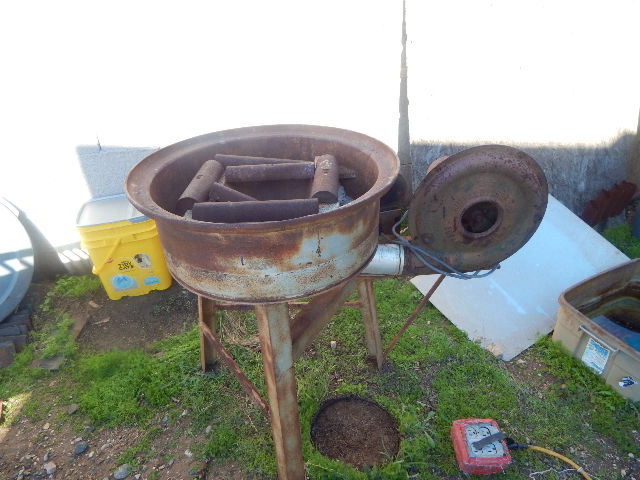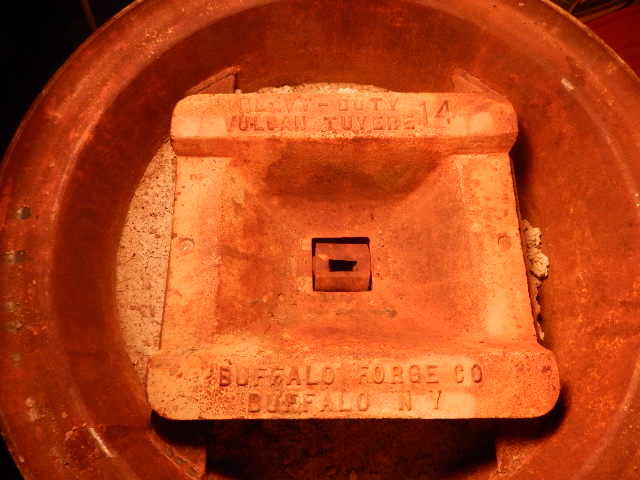So a few years ago I traded a small anvil for an old coal forge. This thing's a beast, but it is solid and came with an electric blower that is variable speed and still works.
Looking down into the forge area, it used to have a lot of white-yellow stuff around the fire-pot that I assumed was some sort of castable refractory. It got wet (several times) and the stuff has pretty much dissolved, so I'm not really sure what it was.
The question is this: Should I replace that stuff? If so, what should I use?
Joshua States
www.dosgatosforge.com
https://www.youtube.com/channel/UCdJMFMqnbLYqv965xd64vYg
https://www.facebook.com/dos.gatos.71
Also on Instagram and Facebook as J.States Bladesmith
“So I'm lightin' out for the territory, ahead of the scared and the weak and the mean spirited, because Aunt Sally is fixin’ to adopt me and civilize me, and I can't stand it. I've been there before.â€
|quoted:
So a few years ago I traded a small anvil for an old coal forge. This thing's a beast, but it is solid and came with an electric blower that is variable speed and still works.
Looking down into the forge area, it used to have a lot of white-yellow stuff around the fire-pot that I assumed was some sort of castable refractory. It got wet (several times) and the stuff has pretty much dissolved, so I'm not really sure what it was.
The question is this: Should I replace that stuff? If so, what should I use?
I read were some folks used Vermiculite to line the bottom of the grill to keep it from burning out. Possibly the same?
Ap green kastolite 26. Is good for like 3000 degree i believe. Flows really easy when casting and is moderately Flux resistant as well. But as far as should you do it, i don't know nothing bout no coal forge. I'm interested to heat what the people say. I've got a line on one of these babies myself.
Jesse
Joshua,
Since no one has really tried to answer your question, I will try.
On some of the old forge tables they would line them with just about anything, fireclay, fireplace mortar, plain dirt, even dirt clay baked. One old recipe uses cement, wood ashes and ground/busted up firebrick. Whatever you use, it should come up to about level or just below the fire pot. That is the oblong funnel shaped box in the middle of your forge. The oblong half round iron bars that you show laying across the fire pot, I have no idea what those are for. And need to be thrown in the scrap bucket in my opinion. I do all of my general forging with coal and have never seen anything like them used before. I do not know whether you have done any forging with coal or not maybe all you have used is a propane forge but hopefully this will help you and give you a start. If you have any more questions I will be glad to do my best to help.
Anthony Griggs
What you appear to have is a duck nest with a clinker breaker sitting in a truck wheel. So it is a home made forge. In order to use this most effectively, you will want to pour the refractory up to level with the edge of the duck nest and "bowl" shape it on up to within a couple inches of the rim of the forge. I don't see any need for the half round bars as part of the forge. You may have to place a sheet metal wind shield around parts of the side but may not depending on where you keep the forge.
Thank you gentlemen, I was hoping to get some experienced coal tenders to help out this clueless fella.....
I have never used a coal forge, well not never, but only once and that was a very long time ago, so it's as good as never (good guess Anthony).
I didn't think the half-round bars were part of this thing, but they came with it and I've never found any use for them so there they stayed. I really do want to set this up and I want to do it right, so I have a couple more questions if you don't mind.
A few experienced coal tenders on another forum told me that this type of firepot was not supposed to be insulated and to do so would be a mistake. Something about it being meant to hang down below a flat surface to radiate heat and prevent a burnout or burn-through. They suggested taking it out of the truck wheel (with Lin that makes two fellas who told me it was in a wheel, so I'm pretty confident that's what it is now)and putting it in a flat piece of plate steel (24"x36") and building a side-draft hood for it. What do you guys think?
The thingy in the bottom of the firepot (what Lin calls the clinker breaker) seems to be some sort of air controller for the blower. How does that work and why? I'll try and take another pic without the iron bars. It's dark outside and I leave before sun up and get home after dark, so it might be Saturday before I get a chance to photograph it.
Joshua States
www.dosgatosforge.com
https://www.youtube.com/channel/UCdJMFMqnbLYqv965xd64vYg
https://www.facebook.com/dos.gatos.71
Also on Instagram and Facebook as J.States Bladesmith
“So I'm lightin' out for the territory, ahead of the scared and the weak and the mean spirited, because Aunt Sally is fixin’ to adopt me and civilize me, and I can't stand it. I've been there before.â€
OK, so I got impatient and went outside with a drop light and camera.
I took two pics of the firepot with the thingy at the bottom in two positions. It looks like it's meant to direct the air flow somehow. It rotates freely and can be turned so there's no opening at all (except around the thingy).
Looking at the shape/design, if I were to set this in a flat table, it wouldn't be enclosed. The flanges don't go all the way around the pot, so two sides would be open and stuff (including burning coal) could fall through.
Joshua States
www.dosgatosforge.com
https://www.youtube.com/channel/UCdJMFMqnbLYqv965xd64vYg
https://www.facebook.com/dos.gatos.71
Also on Instagram and Facebook as J.States Bladesmith
“So I'm lightin' out for the territory, ahead of the scared and the weak and the mean spirited, because Aunt Sally is fixin’ to adopt me and civilize me, and I can't stand it. I've been there before.â€
My first forge was much like this. I put red clay ; from the local creek; in and tapered it from the duck nest up to the rim in a flat bowl shape. Used it for five years, the guy I sold it to has it sitting out in the back yard; still has the clay.
Don't reinvent the wheel.
M
Mike Williams
Master Smith
Joshua, It is a factory fire pot as Lin suggested. Probably cast iron. That is usually what they are made of with a clinker breaker in the center. There should be a 1/2" or so round bar sticking out of the clinker breaker out to the side under the fire pot with a handle on it. Usually the handle is nothing more than the end of the round bar bent at a 90 degree angle to give you a handle to rotate the clinker breaker back and forth. This is so you can turn/rotate it to help clear the airway. Why it is called a clinker breaker I do not know because I have never seen one that would break up a clinker - that will form in the bottom of the fire pot.
I think removing the fire pot and installing it on a larger table/the flat plate would be a very good idea. If you have the room a larger table would be good. Not that I think that it would hurt anything to put some kind of refractory around it, as Mike suggested, but to give you a larger area to hold the coal and give you room to work. If you do this weld some sides 3 or 4 inches high around it but leave an open area in the front and back to give you room to slide in and out what you are working on. A larger table is nice to hold extra coal. You need excess coal so to speak. The extra coal around the fire burns and cokes up and it ready to use as you need it by pulling it into the fire with your fire rake. Hope this helps and not confuses.
Anthony Griggs
Thank you Anthony and Lin, you guys have been extremely helpful. I plan on getting the forge set up this spring and trying some coal forging. Maybe I'll post some pics when I do.
Joshua States
www.dosgatosforge.com
https://www.youtube.com/channel/UCdJMFMqnbLYqv965xd64vYg
https://www.facebook.com/dos.gatos.71
Also on Instagram and Facebook as J.States Bladesmith
“So I'm lightin' out for the territory, ahead of the scared and the weak and the mean spirited, because Aunt Sally is fixin’ to adopt me and civilize me, and I can't stand it. I've been there before.â€





